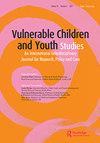Disability, fatigue and peripheral neuropathy in adolescents with perinatal HIV infection
IF 0.9
Q4 FAMILY STUDIES
引用次数: 0
Abstract
ABSTRACT Perinatally HIV-infected adolescents (PHIVA) experience many physical sequelae, but little is known about their levels of disability, fatigue or peripheral neuropathy. This study aimed to determine these sequelae through a cross-sectional analysis in a population of PHIVA and HIV-negative adolescents, based in Johannesburg, South Africa. Outcome measures used were the HIV-related Fatigue Scale, World Health Organization Disability Assessment Schedule 2.0 and the Brief Peripheral Neuropathy Screen, to measure fatigue, level of disability and peripheral neuropathy, respectively. Of the 249 participants assessed, 59% (n = 147) were PHIVA, and the mean age of the participants was 12 years. Clinical data for the PHIVA group showed that the majority (87.1%) were virally suppressed. When compared to the HIV-negative group, PHIVA presented with significantly greater levels of fatigue intensity [1.2(SD±0.5) vs. 1.5(SD±0.9) p = 0.022] and disability [9.2(±6.8) vs. 11.5(±8.9) p = 0.023], with specific limitations in mobility, self-care and participation. No significant differences in peripheral neuropathy were found. In conclusion, PHIVA face challenges with disability and fatigue highlighting the necessity of comprehensive management for this population.围产期HIV感染青少年的残疾、疲劳和周围神经病变
本文章由计算机程序翻译,如有差异,请以英文原文为准。
求助全文
约1分钟内获得全文
求助全文
来源期刊

Vulnerable Children and Youth Studies
FAMILY STUDIES-
CiteScore
1.90
自引率
0.00%
发文量
33
期刊介绍:
Vulnerable Children and Youth Studies is an essential peer-reviewed journal analyzing psychological, sociological, health, gender, cultural, economic, and educational aspects of children and adolescents in developed and developing countries. This international publication forum provides a much-needed interdisciplinary focus on vulnerable children and youth at risk, specifically in relation to health and welfare issues, such as mental health, illness (including HIV/AIDS), disability, abuse, neglect, institutionalization, poverty, orphanhood, exploitation, war, famine, and disaster.
 求助内容:
求助内容: 应助结果提醒方式:
应助结果提醒方式:


